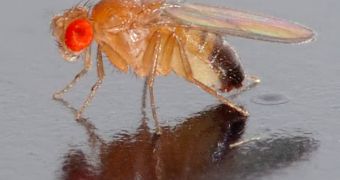The fruit fly (scientifically: Drosophila melanogaster) is the most commonly used model for a very extensive array of scientific experiments, analyzing anything from genetics to cellular evolution and physiology. However, observing its behavior, in both courtship and aggressiveness, is a very tedious process, which can take a researcher hundreds of hours to complete. Experts at the California Institute of Technology (Caltech) have only recently devised a method of making this observation stage a lot easier, by “training” computers to keep an “eye” on the flies and extract patterns from their behavior.
According to its creators, the computer software is able to provide experts with more than half an hour of precise insect movements, in what appears to be real time. Making these observations “manually” is a very boring and prone-to-errors job, on account of the fact that experts see the same thing over and over again. With the new software, their goal, of observing the behavior of the fruit fly, is brought closer in a more accessible method of study.
“Everyone wants to know how genes control behavior. But in order to apply powerful genetic analyses to complicated social behaviors like aggression and courtship, you need accurate ways of measuring – of scoring – those behaviors,” Caltech Roger W. Sperry Professor of Biology David J. Anderson, who is also an investigator at the Howard Hughes Medical Institute and a co-leader of the latest research that has yielded the software, explained.
“In order to screen for mutations affecting aggressive behavior, we would have to analyze something like 2,000 pairs of flies. It's been virtually impossible to do this without a small army of graduate students,” he said of the new program. Before the new application, noticing changes in the genes was a very elaborate job, which required the involvement of many graduate students, who would spend a lot of time looking at how the flies interacted. “We looked at how many instances the computer caught, and how many it missed. By looking at the errors the computer made, we were able to further refine our descriptions to create an even more accurate system,” Anderson added.
“Our visual system tells us a lot about what other people are doing – who is eating, who is beating someone else up, who is blushing, who got the guy or girl. One goal of my field, computational vision, is designing machines that can detect and interpret human intentions, actions and activities. To do that, we need to start with organisms that are simpler and easier to study. David Anderson showed me how interesting and rich fly behaviors are, and so we started collaborating,” Caltech Allen E. Puckett Professor of Electrical Engineering Pietro Perona, who has been the other co-leader of the research, concluded.

 14 DAY TRIAL //
14 DAY TRIAL //